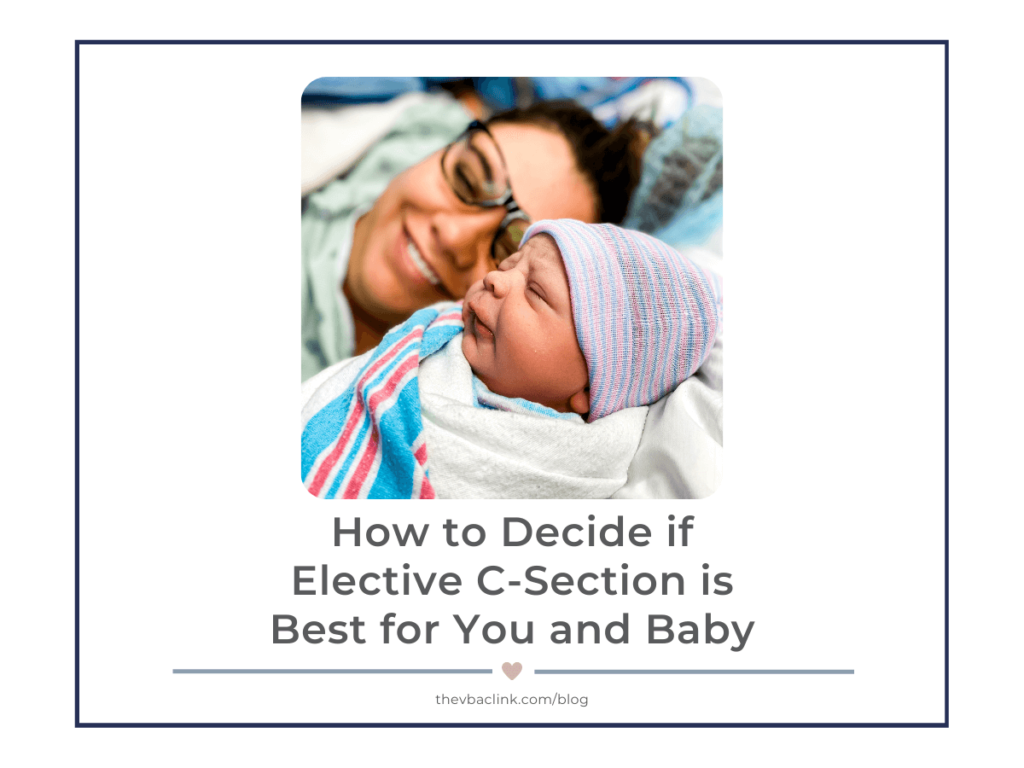
The word elective means that someone is given the option to choose. You may wonder why anyone would choose to have an elective C-section. On the other hand, you may wonder why anyone would choose a natural birth.
In 2020, C-section rates came in at a whopping 31.9% in the United States. This number was actually down from 32.7% in 2013. According to Salimah Walanilarge, the VP of March of Dimes, these high rates are mostly due to the number of elective C-sections.
So why do people have C-sections, and why are people choosing to have them?
Here at The VBAC Link, we encourage people who have had a C-section to learn about vaginal birth after Cesarean (VBAC). We also encourage people to learn about repeat C-section, because there are pros and cons to all the options.
Most importantly, learn about your options, and do what is best for you and your family. We are going to discuss those very things in this blog today.
Medical Reasons for C-section

There are many reasons why people may have an initial C-section, at the recommendation of a care provider.
In addition to the four main reasons for C-sections we start with below, there are a few additional factors. Besides personal preference, there may be a medical reason for an elective C-section to take place.
1. Fetal heart rate
It is normal for babies’ heart rates to fluctuate in labor, both down and up. An average heart rate is 110-160. However, it can go lower than 110 and higher than 160 and still be in the safe range.
Providers may become concerned when a baby in the womb has a heart rate that is constantly going low, with a slower than normal rise back to “normal” range. Similarly, if the heart rate is constantly high, it may be a reason for your provider to be concerned, leading to a C-section.
2. Failure to progress
Failure to progress is another common reason for C-section. The term is used to describe a long “stall” in labor, when there is no change happening cervically. If your water is broken, you have reached 6 cm dilation, and nothing else has changed, this can be called failure to progress.
Before you can technically be diagnosed with failure to progress, it will be determined that:
- The cervix has not thinned or effaced
- The cervix has not opened or dilated
- And your baby has not come down any lower
3. Fetal position
A breech baby is one of the main reasons for a C-section. Although some providers will assist parents in a vaginal birth with a breech baby, it is becoming less common.
It is encouraged to discuss with your provider your options for turning your breech baby before scheduling a C-section.
4. Small pelvis or big baby
It is common for a provider to say that you need a C-section because your pelvis is too small. I was personally diagnosed with a small pelvis. However, a pelvis too small to deliver a baby is rare. Sometimes the baby is not coming down in an ideal position, so it can cause the baby to come down slower than a provider may feel they should.
In addition, if the provider suspects the baby is too large to deliver vaginally, they may suggest a C-section.
5. Birth defects
If it has been shown through medical procedures such as ultrasound or blood tests that a baby has birth defects, a provider may suggest a C-section.
6. A chronic health condition in the birthing person
Many chronic health conditions can play a part in a provider suggesting a C-section.
Many people with chronic health conditions can and do have normal, healthy pregnancies. However, if there are risks with your health condition, it is important to review all your options and ensure that you and your baby have the best possible outcome and birth experience.
7. Placenta previa or accreta
In these conditions, the placenta covers the cervix partially or all the way. If this is the case in the end of pregnancy, there is a chance you may want to choose C-section vs vaginal birth.
8. Previous uterine surgery, including C-section
People who have had a previous uterine surgery or C-section may be suggested to have a C-section.
There are many other reasons that may be a cause for an elective Cesarean, or a medically necessary C-section, and it’s important to discuss these things with your provider. There is never any harm in seeking out multiple opinions.
Why may someone choose an elective C-section?

The way we give birth is very important. It is an event in our lives with a great lasting impact. I am a prime example of this. The way I gave birth to my children molded me into the person I am today.
With my second pregnancy, the operative report shows that I elected for a second C-section. When I saw this, I will be honest, I was upset. A repeat C-section was not what I wanted, but I was being told I needed it.
As I walked down to the operating room to meet my baby girl, I was sad. I felt sad because I was losing an experience that I longed to have. I was also excited to see my precious baby girl.
Back then, I asked myself WHY would anyone EVER choose to have a C-section? The recovery process was not easy, and it was a major surgery.
It wasn’t until I processed my birth experience and started birth work that I understood. In addition to the medical reasons listed above, there are many reasons people have an elective Cesarean.
1. Not knowing options after a previous C-section
One of the leading reasons for elective C-section is not having been given any other option. You may be told you can’t give birth any other way, since you had a C-section the first time.
Back in the 1970’s the phrase “once a Cesarean, always a Caesarean” came into use. This statement is false. However, many providers will still suggest C-sections in subsequent births for their patients.
The success rate for VBAC is 60-80%. Most people who go for a VBAC will give birth vaginally. There are also many things you can do to improve your chances of having a successful VBAC.
2. Pelvic floor issues
The pelvic floor may be of concern if you had previous trauma to it. Even then, there may be concern about giving birth and becoming “damaged” or having issues after birth.
I have heard many people say that one of their biggest fears is tearing down below, and this fear may lead them to choose an elective C-section. They are concerned about what it will do to their intimate life and future physical activity.
3. Convenience
Someone once said you can schedule your birth like you schedule a haircut. While some may not desire to schedule the day their baby will arrive, some people may prefer knowing the date.
It is convenient to be able to plan around a big day, like the day your baby is born. If you are due around the holidays or travel days for yourself or family, it may be nice to know you’ll have everyone there you want on your birth team.
4. Active maternal herpes
It is possible to transfer herpes to a baby if it’s active in the mother. In this case, a provider may suggest a scheduled C-section instead of going for a vaginal birth, even if there has not been a prior C-section.
What could happen in labor that makes me need a C-section?
As parents, we don’t know what we don’t know, and that is okay. In my career as a doula, I sit with clients during their prenatal visits, and answer all their questions. These are some common questions I hear about reasons for an elective C-section, or reasons it may become necessary:
So, the second the baby’s heart rate drops for any reason, I want a C-section right?
If I labor longer than 12 hours can I request a C-section?
If my baby poops during labor or birth, I have to have a C-section, correct?
If it looks like i’m going to tear vaginally, can we stop and just do a C-section?
These are all valid questions for people to ask, and I never want to discredit any questions. If you have questions like these, I encourage you to ask your provider, ask your doula, and get the answers you need.
Don’t be scared to ask any questions, even if you think they are “stupid, silly, or unnecessary.” These are all great questions, and now, let’s go through them together:
If the baby’s heart rate drops for any reason, do I need a C-section?
Fetal heart monitoring is something that may bring comfort for people. But when you hear your baby’s heart rate slow down on a monitor, it can be nerve-wracking. People in your birthing space may react, which does not help in the anxious feelings department.
Fetal heart rate decelerations are and can be normal and healthy. The American Academy of Family Physicians explains which tracings may be more concerning than others. If your baby has a deceleration in the heart rate, movement can often help with that as well as fluids.
If I labor longer than 12 hours, can I have an elective C-section?
This decision will come down to a discussion with your provider. Labor can often take 12-48 hours, especially if you are a first-time parent or you are being induced early.
I know what you are thinking: WOW, that is a long time.
In some ways, it is a long time. However, a medical provider may not view it as long or dangerous if everything is okay. Some parents, after 12 hours of labor, are very tired and just feel done. However, there may not be enough of a medical reason for a provider to perform a C-section.
If labor takes longer than expected or desired, and you are offered interventions, it can be difficult to decide. This article on deciding when to use interventions during birth uses an easy-to-remember acronym to help you consider options as you move along.
If my baby poops during birth, do I have to have a C-section?
If your baby has meconium (aka poops during labor), this is not usually a reason to have a C-section. It may mean that extra staff is needed to assist your newborn, if needed. Sometimes, when a baby poops inside, they can inhale it as they are born. No matter the mode of delivery, the baby may need extra help once they are born.
If it looks like I am going to tear, can we stop and have a C-section?
Tearing can be a big fear for people giving birth. The pelvic floor may affect the way we use the restroom and our intimate life, but there is a lot that we can do to protect it through pelvic movement. We can also do pelvic PT if we encounter tears or incontinence. A C-section may be more that one would like to endure.
What to know if you’re considering a scheduled C-section
As we’ve discussed, there are many reasons why people need C-sections and may choose elective C-sections. There are benefits and risks to both C-section and vaginal birth.
When a birthing family becomes pregnant, we believe one of the first things to discuss with the provider is what their plans are for birth. The provider should go over the pros and the cons for vaginal birth as well as C-section.
For VBAC parents, providers should most definitely discuss the risks and benefits of a trial of labor (TOLAC) for this pregnancy, as well as those for an elective C-section.
Here are some of the benefits and risks.
Elective C-section benefits
- Having a planned date
- Not having to experience labor contractions
- Longer hospital stay, which means more support in the hospital
- Avoiding vaginal tearing or trauma
- Quick birth process
Elective C-Section risks
- Invasive surgery
- Possibly a longer recovery period
- Possible risk of hemorrhage
- Chance of surgical site incision infection
- Risk of blood clots
- Baby has a higher risk of breathing problems
- Possible trauma from unexpected outcomes
- Risks for future pregnancies
Vaginal birth benefits
- Typically an easier/faster recovery
- Quick bonding time for baby after birth
- Baby having an easier transition into the world
- Milk tends to come in faster
Vaginal birth risks
- Pain from contractions during labor
- Unknown amount of time during labor
- Possible chance of urinary incontinence and pelvic floor damage
- Chance of needing a C-section after laboring and or pushing
Elective C-Section or Vaginal Birth: Choose What’s Best for Your Family
Both vaginal birth and elective C-section have risks and benefits to be aware of. The most important thing is that you do what is best for you and your family.
If you want to learn more about elective C-section, we highly recommend checking out how to plan for a natural family centered Cesarean. My second C-section made such a difference because I was able to have a gentle C-section.
If you are unsure or scared of giving birth, no matter what the mode of delivery is, you are not alone, I promise. We support birthing couples in whatever type of birth they choose.
And finally, our VBAC Course for Parents is the place to go if you want to learn everything you can about preparing for a vaginal birth after Cesarean.













 12 Labor Coaching Tips for Anyone to Be the Perfect Childbirth Coach
12 Labor Coaching Tips for Anyone to Be the Perfect Childbirth Coach
Fabulous article!! I’m going to link to it on my Facebook page. Thank you.